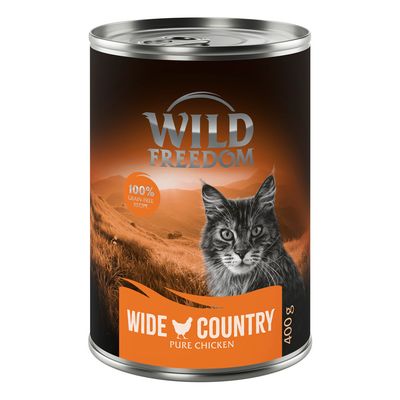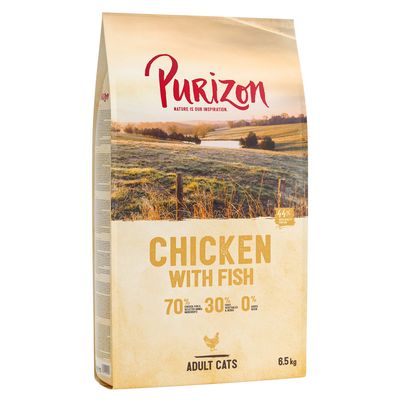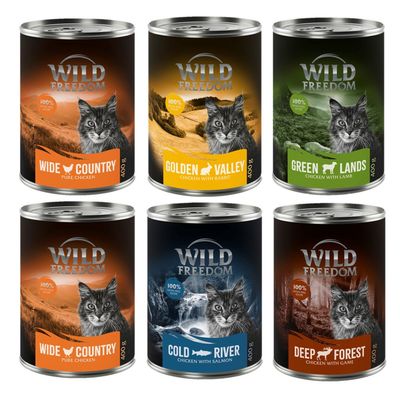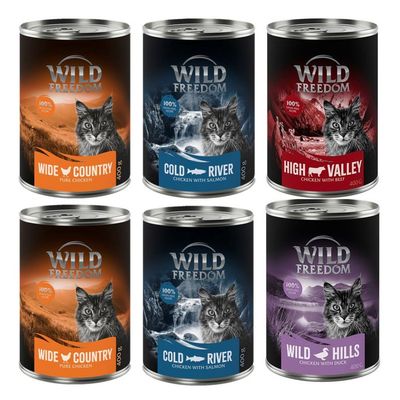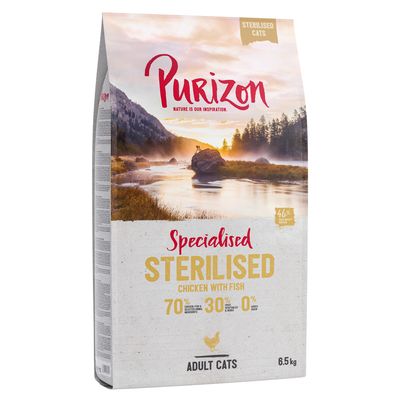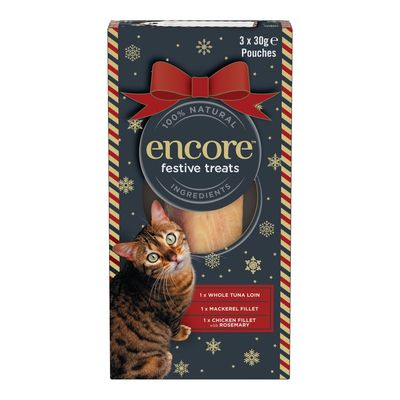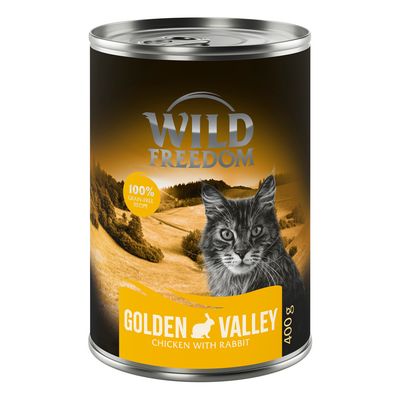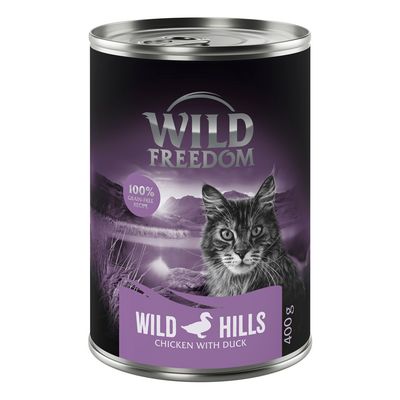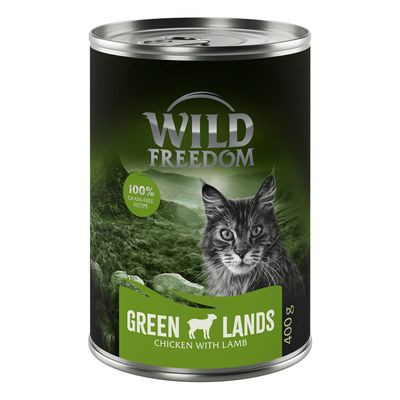Cat Food with High Meat Content
Veterinarian Dr. med. vet. Franziska G. explains: High meat content cat food

"Muscle meat from poultry, beef etc. contains important amino acids, the building blocks of protein. These are essential for many bodily functions, such as muscle strength, the immune system and hormonal control. An important example is the amino acid taurine for cats, as it is crucial for metabolism, heart function and vision. A lack of taurine can therefore lead to serious health problems in cats, such as immunodeficiency, dilated cardiomyopathy (DCM) or retinal degeneration.
Meat not only provides your cat with amino acids, but also healthy fats, vitamins and minerals. As such, too little meat in their food can lead to deficiency symptoms in the long term, which can have a negative impact on your cat's health."
This content is a translation of the original text published on zooplus.de, created by Veterinarian Dr.med.vet. Franziska G., in collaboration with our editorial team. The information provided is for general guidance only and is not a substitute for professional veterinary advice, diagnosis or treatment. Always consult your vet if you have any concerns about your pet’s health or wellbeing.
Veterinarian Dr. med. vet. Franziska G. explains: High meat content cat food

"Muscle meat from poultry, beef etc. contains important amino acids, the building blocks of protein. These are essential for many bodily functions, such as muscle strength, the immune system and hormonal control. An important example is the amino acid taurine for cats, as it is crucial for metabolism, heart function and vision. A lack of taurine can therefore lead to serious health problems in cats, such as immunodeficiency, dilated cardiomyopathy (DCM) or retinal degeneration.
Meat not only provides your cat with amino acids, but also healthy fats, vitamins and minerals. As such, too little meat in their food can lead to deficiency symptoms in the long term, which can have a negative impact on your cat's health."
This content is a translation of the original text published on zooplus.de, created by Veterinarian Dr.med.vet. Franziska G., in collaboration with our editorial team. The information provided is for general guidance only and is not a substitute for professional veterinary advice, diagnosis or treatment. Always consult your vet if you have any concerns about your pet’s health or wellbeing.
What is a high meat content in cat food?
Cat food with a meat content of 60 per cent or more is usually referred to as "high meat content". However, the term "high meat content" is not clearly defined by law. What is considered a high meat content in cat food varies from manufacturer to manufacturer. When choosing a dry or wet food with a high meat content, it is therefore important to pay attention to the list of ingredients and the quantities stated. Please also note that the term "meat" also includes other animal protein sources, such as offal or animal by-products – and not just muscle meat.
What is a high meat content in cat food?
Cat food with a meat content of 60 per cent or more is usually referred to as "high meat content". However, the term "high meat content" is not clearly defined by law. What is considered a high meat content in cat food varies from manufacturer to manufacturer. When choosing a dry or wet food with a high meat content, it is therefore important to pay attention to the list of ingredients and the quantities stated. Please also note that the term "meat" also includes other animal protein sources, such as offal or animal by-products – and not just muscle meat.
Is too much meat in cat food dangerous?
A meat content of 60 to 80 percent in cat food is harmless. However, you should not feed your cat only meat, as this can lead to a lack of nutrients. Cat food with 100 percent meat content should therefore be supplemented with other foods. As important as meat is for a cat's diet, too much meat can pose health risks. These include:
- Digestive problems: If the fibre content decreases due to a meat-only diet, this can have a negative effect on digestion and cause gastrointestinal symptoms such as diarrhoea in cats.
- Bone weakness: An all-meat diet leads to an increase in phosphorus levels, but at the same time a drop in calcium levels. One consequence of this disturbed balance can be a weakening of bones.
- Nutrient deficiency: If your cat receives too much low-fat meat and no suitable supplement, the resulting nutritional deficiency (e.g. too low a fatty acid content) can trigger various health problems (e.g. skin problems, immune deficiency).
Is too much meat in cat food dangerous?
A meat content of 60 to 80 percent in cat food is harmless. However, you should not feed your cat only meat, as this can lead to a lack of nutrients. Cat food with 100 percent meat content should therefore be supplemented with other foods. As important as meat is for a cat's diet, too much meat can pose health risks. These include:
- Digestive problems: If the fibre content decreases due to a meat-only diet, this can have a negative effect on digestion and cause gastrointestinal symptoms such as diarrhoea in cats.
- Bone weakness: An all-meat diet leads to an increase in phosphorus levels, but at the same time a drop in calcium levels. One consequence of this disturbed balance can be a weakening of bones.
- Nutrient deficiency: If your cat receives too much low-fat meat and no suitable supplement, the resulting nutritional deficiency (e.g. too low a fatty acid content) can trigger various health problems (e.g. skin problems, immune deficiency).
Which amino acids in meat are particularly important for cats?
Essential amino acids must be supplied through food, as they cannot be produced by the cat's body. The most important essential amino acids for cats that are found in animal protein include:
- arginine for the excretion of ammonia
- cysteine & methionine to support the skin and coat
- isoleucine, leucine & valine to strengthen muscles and generate energy
- lysine to boost the immune system
- taurine for heart health, eyesight and the nervous system
Which amino acids in meat are particularly important for cats?
Essential amino acids must be supplied through food, as they cannot be produced by the cat's body. The most important essential amino acids for cats that are found in animal protein include:
- arginine for the excretion of ammonia
- cysteine & methionine to support the skin and coat
- isoleucine, leucine & valine to strengthen muscles and generate energy
- lysine to boost the immune system
- taurine for heart health, eyesight and the nervous system
Which proteins should cat food with high meat content include?
A combination of the following animal protein sources is recommended to ensure that your cat receives all the nutrients it needs and that there is no imbalance (e.g. phosphorus-calcium ratio):
| Protein source- | Muscle Meat |
|---|---|
| Reason- | Meat is easily digestible for cats and provides high-quality proteins as well as essential amino acids such as taurine. |
| Protein source- | Eggs |
| Reason- | Egg whites in particular contain valuable protein. However, only feed your cat cooked eggs, as raw egg white contains avidin, which binds biotin and inhibits its absorption into the body. |
| Protein source- | Fish |
| Reason- | Fatty fish species such as mackerel or salmon contain important omega-3 fatty acids (e.g. EPA, DHA), which are anti-inflammatory and have a positive effect on skin health. |
| Protein source- | Offal |
| Reason- | Offal such as liver or kidneys are rich in vitamins (e.g. vitamin A) and minerals (e.g. iron, copper). However, to avoid an excess, offal should only be fed in small quantities. |
Protein source- | Reason- |
|---|---|
Muscle Meat | Meat is easily digestible for cats and provides high-quality proteins as well as essential amino acids such as taurine. |
Eggs | Egg whites in particular contain valuable protein. However, only feed your cat cooked eggs, as raw egg white contains avidin, which binds biotin and inhibits its absorption into the body. |
Fish | Fatty fish species such as mackerel or salmon contain important omega-3 fatty acids (e.g. EPA, DHA), which are anti-inflammatory and have a positive effect on skin health. |
Offal | Offal such as liver or kidneys are rich in vitamins (e.g. vitamin A) and minerals (e.g. iron, copper). However, to avoid an excess, offal should only be fed in small quantities. |
Which proteins should cat food with high meat content include?
A combination of the following animal protein sources is recommended to ensure that your cat receives all the nutrients it needs and that there is no imbalance (e.g. phosphorus-calcium ratio):
| Protein source- | Muscle Meat |
|---|---|
| Reason- | Meat is easily digestible for cats and provides high-quality proteins as well as essential amino acids such as taurine. |
| Protein source- | Eggs |
| Reason- | Egg whites in particular contain valuable protein. However, only feed your cat cooked eggs, as raw egg white contains avidin, which binds biotin and inhibits its absorption into the body. |
| Protein source- | Fish |
| Reason- | Fatty fish species such as mackerel or salmon contain important omega-3 fatty acids (e.g. EPA, DHA), which are anti-inflammatory and have a positive effect on skin health. |
| Protein source- | Offal |
| Reason- | Offal such as liver or kidneys are rich in vitamins (e.g. vitamin A) and minerals (e.g. iron, copper). However, to avoid an excess, offal should only be fed in small quantities. |
Protein source- | Reason- |
|---|---|
Muscle Meat | Meat is easily digestible for cats and provides high-quality proteins as well as essential amino acids such as taurine. |
Eggs | Egg whites in particular contain valuable protein. However, only feed your cat cooked eggs, as raw egg white contains avidin, which binds biotin and inhibits its absorption into the body. |
Fish | Fatty fish species such as mackerel or salmon contain important omega-3 fatty acids (e.g. EPA, DHA), which are anti-inflammatory and have a positive effect on skin health. |
Offal | Offal such as liver or kidneys are rich in vitamins (e.g. vitamin A) and minerals (e.g. iron, copper). However, to avoid an excess, offal should only be fed in small quantities. |
How can you tell if a dry food with a high meat content is high quality?
High-quality dry cat food with a high meat content should contain all essential nutrients (e.g. omega-3 fatty acids, taurine). Transparent labelling and the absence of unhealthy additives are also important.
How can you tell if a dry food with a high meat content is high quality?
High-quality dry cat food with a high meat content should contain all essential nutrients (e.g. omega-3 fatty acids, taurine). Transparent labelling and the absence of unhealthy additives are also important.
What percentage of meat should cat food contain?
A minimum proportion of 60 to 80 percent meat is recommended. To avoid any nutritional deficiencies, a pure meat diet (100 percent) is usually not advisable.
What percentage of meat should cat food contain?
A minimum proportion of 60 to 80 percent meat is recommended. To avoid any nutritional deficiencies, a pure meat diet (100 percent) is usually not advisable.
How much meat should a cat eat per day?
How much meat your cat actually needs depends on individual factors. An average cat generally needs around 25 to 35 grams of meat per kilogram of body weight per day.
How much meat should a cat eat per day?
How much meat your cat actually needs depends on individual factors. An average cat generally needs around 25 to 35 grams of meat per kilogram of body weight per day.








